Tri Bike Brands You Like
We're a little way through our current flash poll, which is a poll we've taken every year or two since 2007. None of what you indicate is a surprise, and while this poll is still up as of this writing, we have enough relevance (more than 600 votes) so that it won't change but a very little if at all.
We wrote a few days ago that this is the time to buy a tri bike—especially with Black Friday/Cyber Monday sales ongoing. Not only are prices good, but demand is likely to outstrip supply in the spring of next year, both because racing will resume, and because the pipeline for parts and factory space remains very tight. Below are a couple of paragraphs about each of these brands—those on the ascendence, and those not—to help you choose among them if you decide a tri bike is in your future.
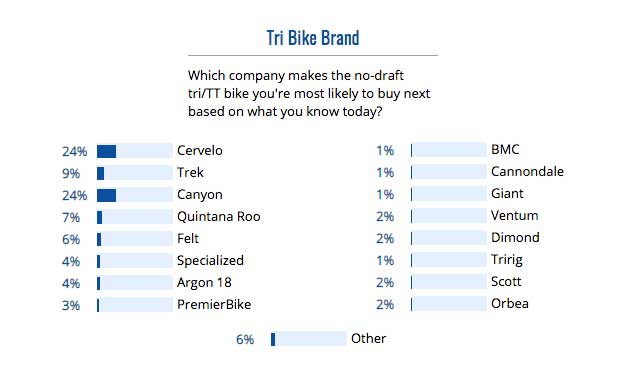
Canyon
If you consider the trajectories and strategies of, say, Trek and Specialized, Canyon is heading in the opposite direction, at least in triathlon. Bike launches are like biorhythms. You launch, you sell, you engineer, you manufacture, you launch something new, and that’s a life cycle. Canyon has been at the end of a long life cycle and if I’d have written this 3 months ago it would’ve been: wow! Canyon needs to wake up, and step on the gas pedal! Which is what I’m saying about Specialized and Trek now. So, maybe it’s just a matter of timing. But Canyon did come out with a new tri bike lineup, and not just a halo bike but a whole new disc brake lineup, top-to-bottom. This is probably why Canyon is a co-leader of this market share preference poll at 24 percent.
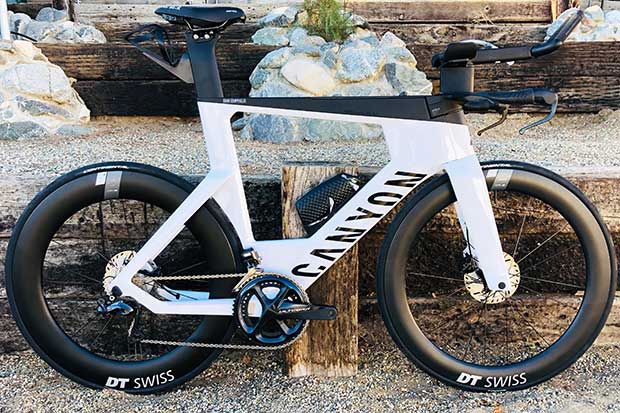
The founder of Canyon was (before founding Canyon) the German distributor of Quintana Roo bikes in the 1990s. He was and is a good friend of mine, and he had a heart for triathlon then and has one now. This is one reason why Canyon has that strong triathlon following: It probably has more of a heart attachment to tri than it does to any other cycling sub-specialty. Triathletes feel it when you take their needs seriously. The reason Canyon, Cervelo and QR hold a combined 54% brand preference, and Trek, Specialized, Giant, Scott and Cannondale – with a combined sales probably north of $5 billion – are at a combined 16%, is that triathletes pay attention to you when you pay attention to them.
Cervelo
Like Canyon and Quintana Roo, triathlon is in this brand’s DNA. This co-leading brand (in our poll) is a relentless launcher of new tri bikes. They just kept hitting us over the past few years, relentlessly, like Mike Tyson, with intro after intro, the P5X, the P5 Disc, the P3X, the P-Series, and every bike had a specific use in mind, and performed according to that use (both the use case and the price target).
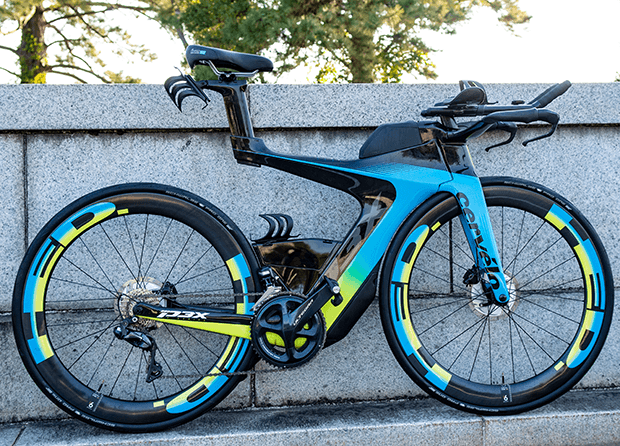
Cervelo’s biggest issue in 2020 was the pandemic. Let’s be honest. Direct sellers killed it during the pandemic, while IBD brands had to work for it, fabricating wartime-like processes to deliver bikes. But you can’t keep a good brand down. Cervelo found a way to get its bikes out the door. And, you all found a way to get your Cervelos. Just, you probably were more likely to buy a Caledonia (the brand really hit the bullseye on this new road bike) than a tri bike, because lifestyle bikes are what sold in 2020. Tri bikes are what will sell as we lead into 2021.
Trek
Trek is at 9% Slowtwitcher brand preference and I guess I’m impressed it remains this high (Trek has always hung around 10 or 12 percent in these polls). If the brand has produced a new tri bike in the last 6 years I missed it. What it sells is a rim brake tri bike last updated (to my knowledge) in 2014, which was a rather mild change from the original, and the original was launched in 2011 (I wasn’t all that thrilled with the 2014 updates). The least expensive complete bike that I see currently offered sells for $4,200.
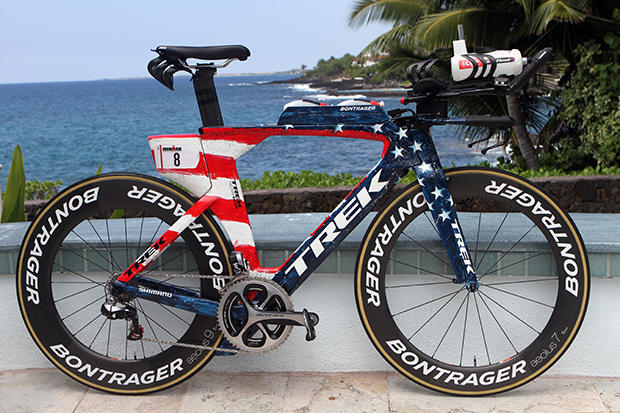
What this says is, terrific brand loyalty. A testament to the brand. Further, let’s be clear about what Trek did right. First, that 2011 launch of the Speed Concept was revolutionary. If you look at how clean new Canyons and Cervelos are today, with loads of integrated storage and electronics, this is what Trek did almost a decade ago. Likewise adjustability and comfort in the front end. Also, Trek really pioneered mass customization with the Project One platform, and if I were to buy a Speed Concept today this is how I would buy it. It’s got a huge dealer network; the ability to get the bike my way; the revolutionary platform; it’s all there. I just am surprised that Trek still generates this loyalty off a platform that’s this old. In a way, it’s a testament to whatever Trek gets right that Specialized – its chief rival – can’t match, because, other than Specialized’s halo-priced Shiv Disc, both these companies are selling old platforms, and Trek continues to be rewarded by customers while Specialized? Not so much.
Quintana Roo
This brand sits in 4th in Slowtwitcher brand loyalty among tri bike makers, within striking distance of Trek in brand preference. If Trek doesn’t come out with anything in 2021, I suspect QR will overtake Trek, trailing just Cervelo and Canyon. In fact, I suspect QR is ahead of Trek right now at the cash register. Why? For starters, nobody can – ahem – match the pedigree of this brand. Trek and Specialized can outspend QR 100-to-1 on engineering, marketing and distribution, but that will never change the fact that these two brand giants make bikes today that QR pioneered and popularized in the late 80s and early 90s. Canyon was actually part of the QR revolution as discussed above. This is one reason why Canyon has that strong triathlon following. Cervelo? This was the brand that took QR’s bones and dressed it with a skin that captured the imagination of athletes. These are the 3 current brands with the strongest historical attachment to triathlon.
This isn’t to say QR has not had its time wandering the wilderness. I was not a huge fan of the bikes it built in the aughts. What changed was the PR series. This is when Quintana Roo made a platform that was true to its roots. This is also, among all the top bikes, the brand that has more of the product built in the U.S. You could say that it took Trek’s Project One idea and leveraged it past Trek’s own ambitions. QR does all its painting and assembling in its Chattanooga factory, and I always find it comforting when the folks who make parachutes, or high explosives, or bicycles, actually understand the function behind the job they do (because of the consequences attached to a job done poorly).
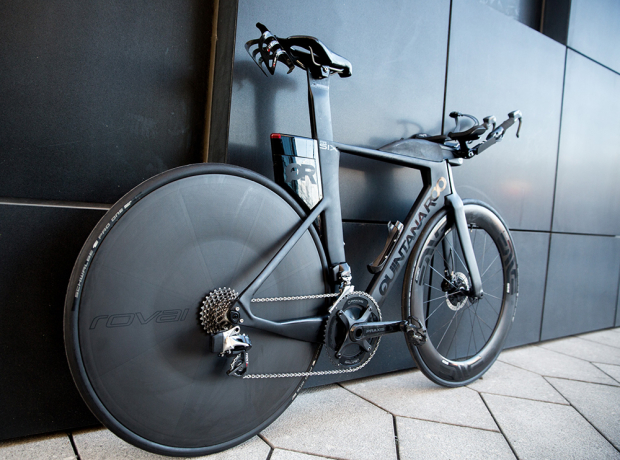
The final reason I think QR might have already surpassed Trek in tri bike sales is that QR is ahead of Trek in the modern art of niche sales. Have you noticed that quarter after quarter niche endurance brands are doing very well, and their online sales are skyrocketing? Of course(!) you say! We’re in a pandemic! But there’s more to it. As Jeff Goldblum’s character in Jurassic Park put it, “Life finds a way.” When it comes to the stuff we need to ply our endurance avocations, we—you and I—find a way. QR is better positioned to leverage our determination to find a way, by exploiting every possible sales channel. From your tri club, your LBS, your race expos, to your inbox, QR is often there.
Felt
This brand was at 9 percent Slowtwitch brand preference in 2007, for tri bikes. It shot up to 12 percent in 2009, and 14 percent in 2011. Why? Because right around 2007 it ditched a bad geometry (its S-22 back then was just way too low in front) and it started making geometries people could ride. Also, it came out with the DA in 2006, and off the DA and the B-series bikes Felt rode up the brand preference escalator.
Then Felt introduced the IA in 2013 and when we polled you all on what superbikes you liked the best, 36% of you selected that bike, while 28% selected Trek’s Speed Concept and remember, the Speed Concept was still riding high, having only been release 2 years earlier. In 2016 Felt still was sailing a tailwind at 14% brand preference, because it very aggressively pushed the IA platform down in price, making a popular platform more affordable. Felt remained at 14% brand preference among you all through 2017, in a flash poll in which more than 2000 of you participated, and that made Felt the second-most popular brand behind Cervelo.
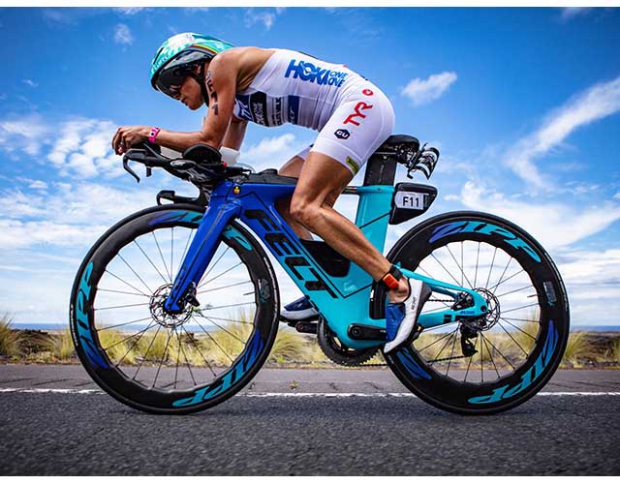
By 2018 brand preference had fallen to 12%, as Canyon began to sell in the U.S., and to 9% by 2019, then to 7% later in 2019, and to 6% today. Felt did come out with the IA Disc in 2018 and Daniela Ryf rode during her victory in Kona, scorching the bike leg in 4hr26min. But Felt hasn’t kept pace with the other marquis brands in certain areas, namely the front end (handlebars, aerobars, stem). Orbea, Cervelo, Canyon and others have done a really good job with their own proprietary front ends (aerobars, pursuit bars, integrated stem systems), while Quintana Roo has partnered with Profile Design in smart ways (integrating the best of PD’s aerobars with QR’s integrated stems). Felt has made its own aerobars for well more than a decade, but has not in my opinion kept up. The affordable IA series (IAx) seems not to have been manufactured in 2020, leaving the B series the only tri bikes sold below $5,000 and that is an old, old platform.
Specialized
This brand seems to me a lot like Nike, in that it keeps its ear to the tracks, and it ebbs and flows in road, MTB, gravel, eBike, tri based on trends. I don’t blame them. However, this doesn’t work as well in tri. You have to fight the battle, year after year, in order to remain relevant. As a result, Specialized is often trying to regain market share and brand loyalty it lost during those moments of ebb. It had 6% brand preference here in 2007, up to 7% in 2009, and up to 11% in 2011 off the intro of the Shiv. Both Chris McCormack and Craig Alexander rode their Shivs to victory in Kona, but then Specialized seemed to have lost its enthusiasm for tri and Slowtwitchers lost their enthusiasm for Specialized. Brand preference was down to 6% in 2016, and 5% in 2017 and 2018.
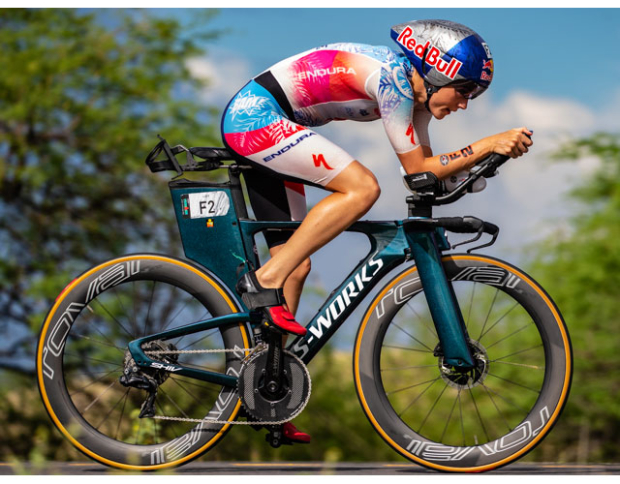
That share fell to 3% last year because, while Specialized did announce the Shiv Disc in late 2018, they didn’t deliver the bike for a long time. Yes, you can get it now, and perhaps that’s why the brand preference is up to 5%. But Specialized never did downstream that bike to an affordable price. There’s a lot of $13,000 variants of the Shiv Disc, and one “budget” $8,500 version, but below that what you get is the ancient Shiv platform. Again, I’m not blaming Specialized, 2020 was the perfect year not to have a new tri bike. But they’re now a barely relevant company in triathlon, hovering between 4 and 5 percent brand preference, and if triathlon storms back in popularity they’ll have a lot of catching up to do.
Argon 18
This brand hangs around, on the periphery of our vision, making excellent tri bikes from the entry level up to sky’s-the-limit. There’s always been a vibrant cottage-to-large French Canadian bike industry: Louis Garneau, Guru, Marinoni, Devinci, Squad (with roots in Kuota). Dorel Industries, Cannondale’s parent company, is based on Montreal. Most of these brands have had a pretty significant triathlon focus and this is the case with Argon 18.
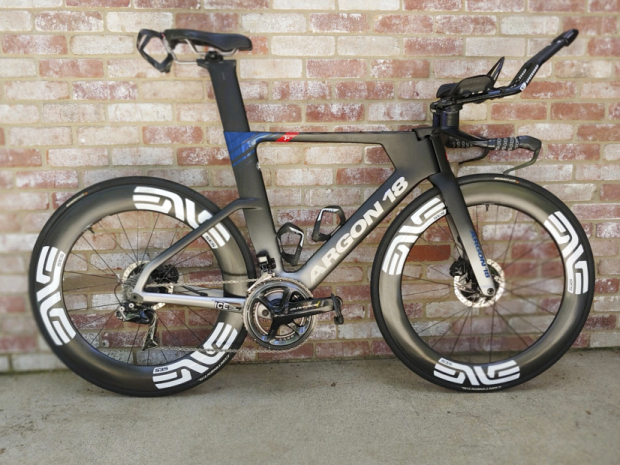
This brand’s problem in the U.S. has always been the difficulty in figuring out U.S. distribution. The most promising strategy was the deal in 2009 with Sinclair Imports (outside of Reno, NV) to distribute the brand in the U.S. But alas, Sinclair did not survive as so many companies, like Shimano, chose to abandon most of the fractured distributor network. But Argon 18 still survives and perhaps technology and shifting sales channels has caught up to the excellent bicycles this company makes. I have made no secret of my admiration for Peter Hurley, who owns American Bicycle Group (Quintana Roo, OBED, Litespeed). What ABG figured out (see my notes on Quintana Roo above) is how the midrange brand survives and prevails today. What Argon 18 does not need is an overhaul of its bikes. What it does need is shrewd ABG-like logistics and sales strategies. I’m reminded of the speech of Gene Hackman’s character in Enemy of the State: “If they're big and you're small, then you're mobile and they're slow. You're hidden and they're exposed. You only fight battles you know you can win.“
When Argon 18 has as much tri bike brand appeal among Slowtwitchers as Specialized, it’s because the customer understands that you’re there, with them, year-in and year-out.
The Others
I don’t see the bike market getting more assembly-line, or more big-brand aggregated. As we see mid-sized brands; brands that offer more customization; brands that appeal through various sales channels; brands that can retain a sport-specific focus all the time, rather than repeatedly forgetting and remembering niche activities like triathlon; win the brand preferences battle among you all.
Therefore, the others in this poll—and some of those in the "other" category— are worth considering. Scott and Orbea each have new tri bikes. Ventum, Dimond and PremierBike are compelling options as well, as are TriRig, Parlee and others.



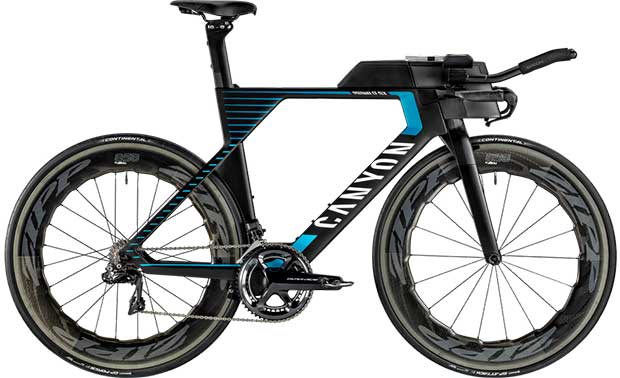
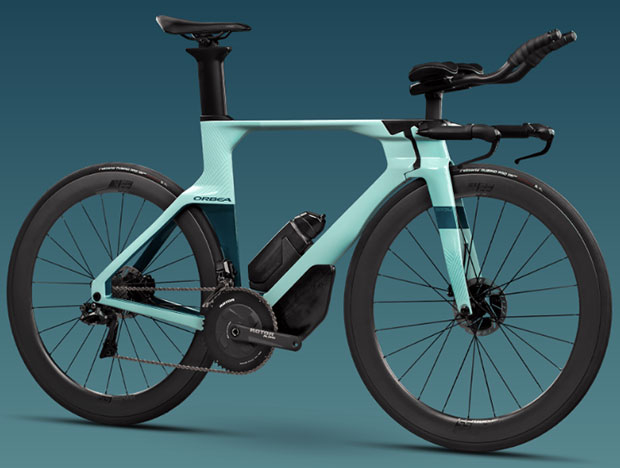
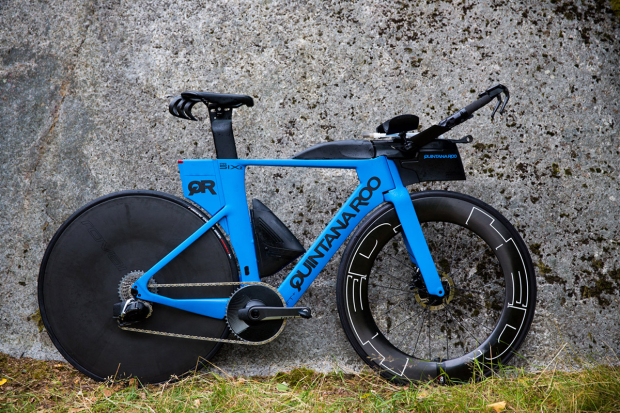

Start the discussion at forum.slowtwitch.com